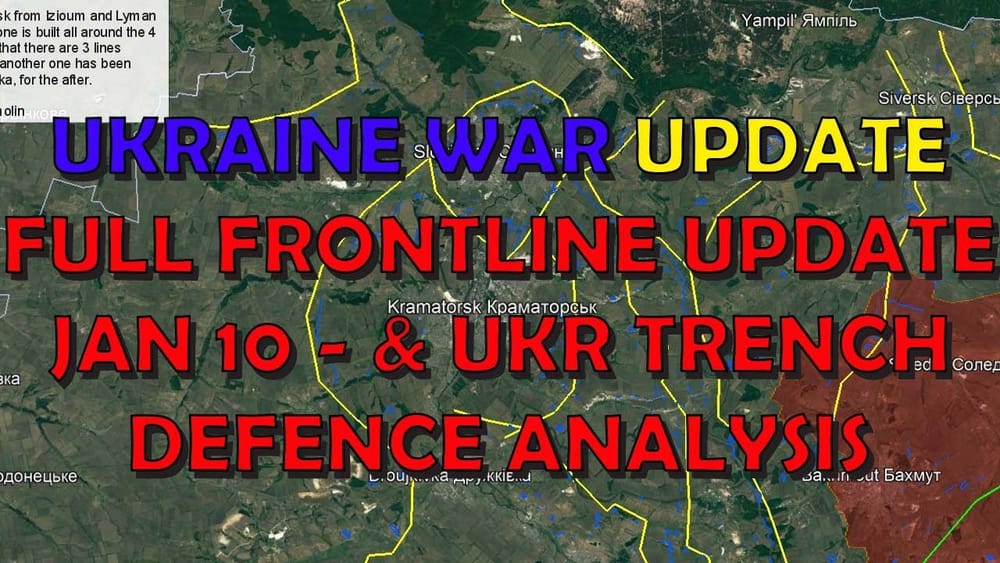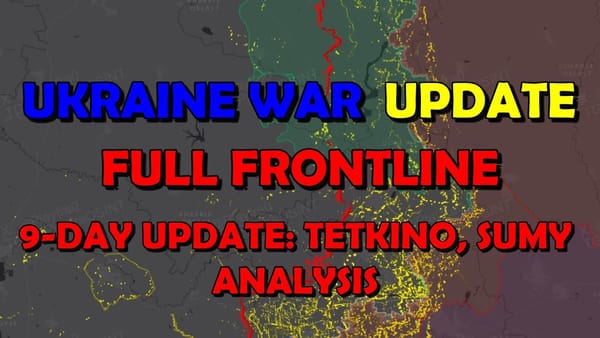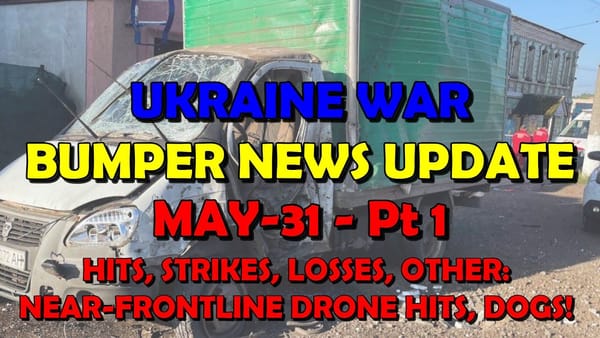Ukraine Conflict: Full Frontline Update & Ukr Trench Defences
Table of Contents 📖
"Russia can't win this; the only way they can prevail in this war in any way is contingent upon China."
Hello Team
🎦 00:00-00:20⏩
Jonathan welcomes viewers to another ATP Geopolitics frontline update and expresses gratitude to JR for his assistance with mapping. He acknowledges the current high volume of information and notes that there haven't been significant changes on the front lines.
Return to top⤴️
📍 FRONT-LINE UPDATE -🗺️ MAP LEGEND

Kupyansk-Svatova-Kreminna Frontline Analysis
🎦 00:20-03:25⏩
Jonathan discusses the Russian counteroffensive announced in October 2023, highlighting its lack of progress. He cites a Romanian analyst who points out that despite deploying significant resources, the Russians have gained very little ground. The analyst estimates Russian losses at over 400 armoured vehicles and potentially 30,000 personnel. Jonathan acknowledges some minor Russian gains near Svatova and Synkivka but emphasizes their limited strategic significance given the scale of the Russian offensive.
Return to top⤴️
Ukrainian Counter-attack East of Terny
🎦 03:25-04:15⏩
Jonathan discusses reports of Ukrainian forces stabilizing the frontline east of Terny after receiving reinforcements. He cites sources suggesting successful Ukrainian counter-attacks in the area, pushing back against Russian advances.
Return to top⤴️
Bakhmut Frontline Update
🎦 04:16-07:43⏩
Jonathan reports no significant changes on the Bakhmut frontline. He cites Kenneth Greg, a Finnish fighter, who mentions ongoing fighting in various locations, including Bohdanivka, where Ukrainian forces reportedly pushed back Russian troops. The Russians aim to improve their position by capturing ridges at Klishchiivka. Jonathan emphasizes the strategic importance of Klishchiivka's western heights for controlling the area. He also highlights the slow pace of the Russian offensive and doubts their ability to easily capture Chasiv Yar due to its fortifications and the Ukrainian military's determination to defend it.
Return to top⤴️
Avdiivka Frontline Update
🎦 07:43-13:12⏩
Jonathan observes a reduction in fighting intensity around Avdiivka, despite previous heavy combat. He cites the Institute for the Study of War (ISW) acknowledging that Russian advances are likely to continue at a gradual pace. Jonathan analyzes the strategic importance of Avdiivka as a potential springboard for further Russian operations but questions the feasibility of a rapid advance. He attributes the Russian offensive in the area to political motivations, specifically Putin's desire for a victory ahead of the March elections. Despite Avdiivka's vulnerability due to its reliance on a single supply road, Jonathan acknowledges the resilience of Ukrainian defenses, which have inflicted heavy losses on Russian forces. He believes that capturing Avdiivka, while strategically advantageous, would be a pyrrhic victory for Russia.
Return to top⤴️
Marinka and Vuhledar Frontline Updates
🎦 13:12-15:08⏩
Jonathan notes no changes in Marinka but mentions rumours of a potential Ukrainian counter-attack north of the water features. He reports Russian gains south of Novomykhailivka, with both Deep State Map and Surat Maps reflecting this development. He thanks JR for updating the Deep State Map to reflect the expanded frontline. He also mentions a lack of significant activity around Vuhledar.
Return to top⤴️
Kinburn Spit and Kherson Frontline Update
🎦 15:08-19:47⏩
Jonathan discusses the situation on the Kinburn Spit, where Ukrainian forces hold a small bridgehead. He cites reports suggesting a potential Ukrainian advance in the area. Jonathan plays a clip from Andrew Perpetua's analysis, which includes footage of Russian Krasnopol laser-guided artillery strikes on Ukrainian positions. Jonathan notes the effectiveness of Ukrainian electronic warfare capabilities in the area, giving them a significant advantage in drone warfare and contributing to heavy Russian losses. He expresses concern for the well-being of Ukrainian soldiers on the Kinburn Spit, describing it as a "meat grinder" due to the intense fighting and heavy Russian artillery fire.
Return to top⤴️
Novomykhailivka Frontline Analysis
🎦 19:47-25:24⏩
Jonathan shifts the focus to Novomykhailivka, reporting that Russian forces have been pushed back from their recent advance. He cites Andrew Perpetua, who described the area as littered with destroyed Russian equipment. Despite heavy bombardment, Ukrainian forces, including intelligence units and drone operators, successfully defended Novomykhailivka. Jonathan sees this as positive news for Ukraine and speculates on potential future developments in the area. He suggests that instead of directly attacking settlements, Russian forces may try to encircle them and cut off supply lines.
Return to top⤴️
Analysis of Ukrainian Defensive Lines
🎦 25:24-38:27⏩
Jonathan addresses viewer questions regarding Ukrainian defensive lines, presenting detailed information based on recent data and satellite imagery. He highlights the extensive network of trenches, bunkers, and fortifications Ukraine has constructed, particularly in the Donbas region, drawing comparisons to the Russian Surovikin line. Jonathan emphasizes the strategic importance of the "Donbas Line", a complex system of fortified positions designed to slow down or halt a potential Russian advance. He explains the advantages of Ukraine's approach, which prioritizes defense in depth and utilizes natural barriers like rivers and lakes. He discusses specific defensive lines, including:
- The "Surovikin Line": Marked in yellow on his map, Jonathan acknowledges its effectiveness in hindering the Ukrainian counteroffensive in the summer of 2023.
- The pre-2022 Russian defenses: Jonathan notes their potential use by Ukrainian forces in case of a breakthrough.
- The "Donbas Line": Unlike the continuous nature of the Surovikin line, the Donbas Line consists of interconnected fortified positions separated by open terrain. This strategy aims to prevent the loss of the entire line if one section is overrun.
- The "Ukrainsk-Mariinka Line": Located south of Kurakhove, this line showcases Ukraine's use of satellite imagery and strategic planning. Fortifications are spaced at least a kilometer apart, allowing for mutual defense and creating a formidable obstacle for attackers.
- The "2014-2015 Popasna-Luhansk Line": Though abandoned, this line exemplifies the importance of troop deployment and tactics in defensive operations.
- The "Zero Line": This line, consisting of multiple layers near Mariupol, Popasna, Marinka, and Horlivka, suffered from a lack of personnel, leading to its quick collapse.
- The "February-June 2022 Line": Constructed during the initial phase of the invasion, this line south of Bakhmut and towards Siversk demonstrates Ukraine's adaptability in building defenses under pressure.
- The "Northern Donbas Lines": Lines 1, 2, and 3, still under construction, highlight the ongoing efforts to fortify the region.
- The "Kramatorsk-Slovyansk Defenses": These defenses include multiple trench lines, anti-tank ditches, and fortifications designed to protect these strategically vital cities.
- The "Other Defensive Lines": Jonathan mentions additional lines in Zaporizhzhia, Luhansk, and Kharkiv Oblasts, demonstrating the comprehensive nature of Ukrainian defense preparations.
He concludes by acknowledging the ongoing nature of these defensive preparations and emphasizing the importance of vigilance and continuous improvement.
Return to top⤴️
Wrap up
🎦 38:27-38:33⏩
Jonathan concludes the video by inviting viewers to share their thoughts and thanking them for watching.
Return to top⤴️



